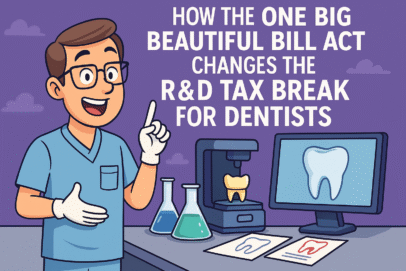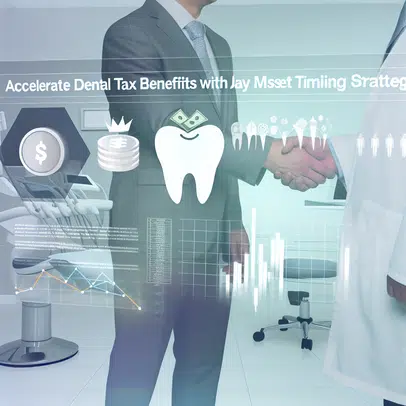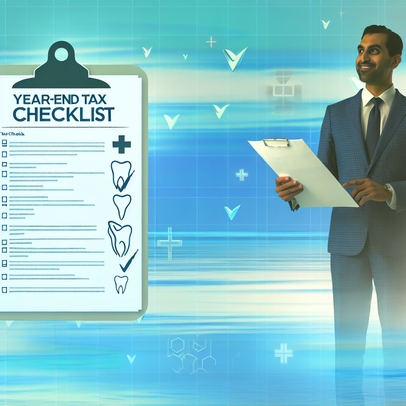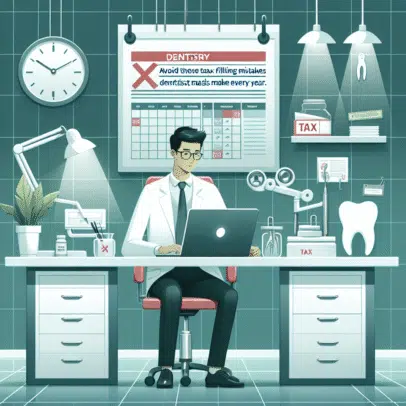How the One Big Beautiful Bill Act Changes the R&D Tax Break for Dentists
Tax laws have shifted again—this time with provisions that could make a real difference for dental practices that develop new tools, workflows, or technology. The One Big Beautiful Bill Act (OBBBA), passed in 2025, reintroduces the ability to write off most U.S.-based research and experimental (R&E) costs right away, instead of spreading them out over several years.
For dentists and dental labs that genuinely invest in innovation—think new lab processes, clinical protocols, or proprietary software—this is a chance to improve cash flow and potentially claim a valuable research tax credit at the same time.
Here’s what this change means, who it helps, and how to tell if your practice qualifies.
A Quick Refresher: What Changed in 2025
For years, businesses could immediately deduct the money they spent on research and experimentation in the U.S. That changed in 2022 when a rule forced companies to capitalize those costs (spreading the deductions over five years domestically, or 15 years for international work).
The OBBBA restores immediate expensing for U.S.-based R&E costs starting in 2025, making it easier to recover those expenses right away. If your research happens overseas, you’ll still have to spread out the deductions over 15 years.
The law also offers a catch-up deduction for practices that were forced to capitalize their research costs between 2022 and 2024. This lets you claim the remainder of those costs in 2025, helping offset taxes in the current year.
Deduction vs. Credit: Two Different Benefits
It’s easy to confuse the R&E deduction with the R&D credit, but they’re two separate tax benefits:
- The deduction lowers your taxable income by letting you write off your research spending as a business expense.
- The credit is a direct reduction in the tax you owe, based on a percentage of qualifying research expenses.
Dentists can often use both, but there are coordination rules: If you claim the full R&D credit, you have to reduce your deduction by that credit amount. Many practices choose an election that slightly reduces the credit instead, allowing you to keep the entire deduction.
What Actually Qualifies as “Research”?
Here’s where most practices get tripped up: Regular patient care, case planning, and day-to-day problem-solving don’t count as research for this credit. The IRS looks for structured, documented efforts to solve technical challenges or create something new.
In the dental world, qualifying activities might include:
- Innovative lab processes: Testing new milling, sintering, or bonding protocols with measurable, documented results.
- Custom software development: Writing proprietary tools to automate imaging, case planning, or lab workflows.
- Material or device R&D: Experimenting with new composites, implants, or instruments through structured trials.
- Formal clinical studies: Running documented studies with test groups, metrics, and hypothesis-driven protocols.
What doesn’t qualify:
- Routine chairside adjustments, esthetic choices, or adopting vendor-provided workflows.
- Staff training, continuing education, or purchasing equipment off the shelf.
- Marketing campaigns or patient communication improvements.
In short, if you’re solving technical uncertainties through a process of experimentation, you might have a case.
What Counts as a Qualifying Expense?
For practices or labs that truly meet the R&D criteria, here are examples of eligible costs:
- Wages for staff directly engaged in the experiments, as well as those supervising or supporting them.
- Supplies used during testing (like resins, discs, prototype parts, or chemicals).
- Portions of contractor fees paid to U.S.-based vendors working on your R&D project.
- Cloud hosting and data processing costs tied to software development.
Why This Change Matters
If you’ve been investing in innovation, the OBBBA change means you no longer have to wait years to deduct those costs. The benefits include:
- Faster tax savings: Writing off R&E spending in the same year you incur it can dramatically lower your taxable income.
- Better cash flow: Recovering more upfront means more money to reinvest in your practice or lab.
- Catch-up deductions: You may be able to claim deductions for past research expenses that were stuck in amortization between 2022 and 2024.
- Stacked benefits: Pairing the deduction with the R&D credit, when done correctly, can yield even more savings.
Practical Example
Imagine a multi-location dental group with an in-house lab. Over the past two years, they experimented with a new ceramic layering technique. Their team spent $80,000 on trial materials and $150,000 on employee wages tied to these tests. Under the old rules, they would have had to deduct those costs over five years, getting back only a fraction each year.
Under the new law, they can:
- Deduct the entire $230,000 in the current tax year.
- Potentially claim an R&D credit worth thousands more.
The immediate savings not only lower this year’s tax bill but also provide more capital for future innovation.
Common Misconceptions
“I’m a dentist, so this doesn’t apply to me.”
Many dental practices won’t qualify for the R&D credit—but dental labs, multi-location groups, and research-focused practices often do. If you’re building custom software, developing proprietary workflows, or conducting clinical research, it’s worth exploring.
“Buying new equipment counts as R&D.”
Purchasing a 3D printer or milling machine isn’t research—it’s an investment in capital equipment. While you may write off that purchase using Section 179 or bonus depreciation, it’s not part of the R&D program.
“I don’t have a research department.”
You don’t need a full-blown lab to qualify. The IRS cares about your activities, documentation, and intent, not your organizational structure.
How to Prepare for an R&D Claim
If your practice or lab is innovating, here’s how to lay the groundwork for a strong R&D claim:
- Document everything: Keep detailed records of trials, changes, failures, and results. Meeting notes, photos, and software logs all help.
- Track time: Have employees log time spent on qualifying research.
- Separate expenses: Use dedicated accounts or codes in your accounting system for R&D wages, materials, and contractor costs.
- Work with a specialist: The credit is complex, and missteps can trigger audits. Partner with a CPA or R&D tax credit consultant experienced in healthcare and technology.
Planning Around Past Years (2022–2024)
The OBBBA law also addresses the period when research costs had to be capitalized. Practices that had qualifying R&E costs in those years may have unamortized balances sitting on their books. The new rules allow you to accelerate those deductions in 2025, potentially producing a large tax benefit in a single year.
Questions to Ask Your Accountant
When you meet with your tax advisor, ask:
- Do we have any activities that meet the IRS’s four-part test for research?
- How much of our costs could qualify for the credit vs. just the deduction?
- Should we make the election to reduce the credit so we can keep the full deduction?
- Can we reclaim past expenses under the new rules?
- Should we reorganize entities (lab vs. practice) to optimize benefits?
Action Steps for Dental Entrepreneurs
- Audit your innovation pipeline: Identify any internal projects that were more than just routine improvements.
- Start documentation habits now: Even if you’re not ready to claim, build the habit of documenting technical experiments.
- Get professional input: Have your CPA or a specialty firm review your 2022–2025 expenses.
- Coordinate with other credits: The R&D credit is just one piece—combine it with Section 179, bonus depreciation, and other tax planning to maximize savings.
- Stay conservative: Only claim credits you can defend with solid evidence.
Bottom Line
For most small dental practices, the R&D credit still won’t apply. But for innovative practices, labs, and dental entrepreneurs, the OBBBA’s restoration of immediate R&E deductions and coordination with the credit is a welcome change. It rewards those investing time and resources into advancing dentistry, whether through digital workflows, custom devices, or research-backed techniques.




